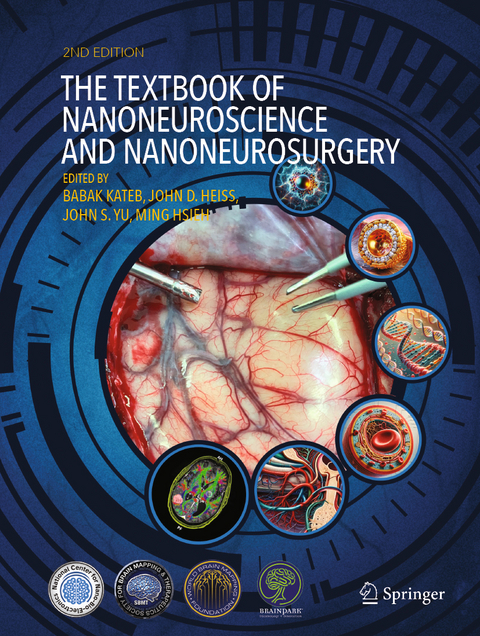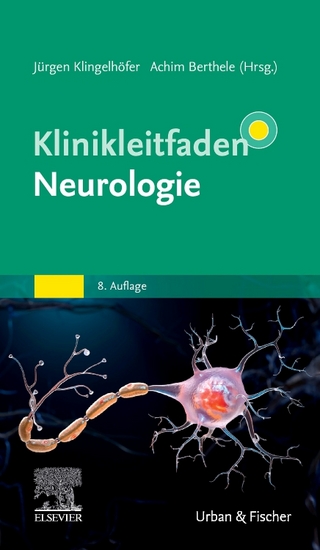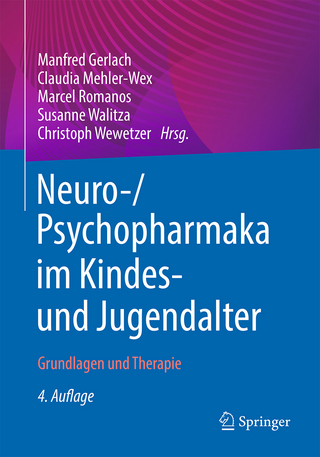
The Textbook of Nanoneuroscience and Nanoneurosurgery
Springer International Publishing (Verlag)
978-3-030-80661-3 (ISBN)
This textbook highlights the exciting field of nanoneuroscience and its potential to transform how we diagnose and treat neurological disorders. "The Textbook of Nanoneuroscience and Nanoneurosurgery," dives deep into this emerging field, exploring the latest tools and techniques currently being developed at the nanoscale level. Key areas of focus include:
Nanoplatforms: The book explores how scientists utilize materials on a near-microscopic scale for neurosurgery, neurology, and brain imaging applications.
Bridging the Gap: Regulatory hurdles for translating research from the lab to real-world use are addressed, paving the way for future advancements.
The Future is Now: The book showcases recent breakthroughs already impacting patient care alongside promising areas with significant potential.
Collaboration is Key: Insights from over 220 researchers and 5000+ references, along with illustrative figures in B/W and color, provide a comprehensive overview of this dynamic field.
With its focus on minimally invasive procedures and the latest regulatory considerations
"The Textbook of Nanoneuroscience and Nanoneurosurgery" equips researchers and medical professionals with the knowledge to develop groundbreaking treatments for neurological conditions.
The text also reviews the latest regulatory guidelines that influence the translation of nanotechnological research from the laboratory to the clinic and the most recent information on biodevices and pharmaceutical spinoffs. It highlights presidential and congressional initiatives and programs that may impact the field soon.
Some reviews of the First edition of the textbook.
"...a significant contribution to the field of nanoneuroscience and nanoneurosurgery ... the reader will come away with a deeper understanding of the history of nanotechnology and medicine."
-Neuroscience
"This is a monumental first textbook on nanoneurosurgery. ... recommended reading for neurosurgeons, neurologists, neuroradiologists, and neuroscientists involved in research on new techniques for application in neurosurgery. Biomedical engineers and various companies developing instruments and devices would benefit from the wealth of information about trends for the development of new technologies for neurosurgery."
- K. K. Jain, MD, Basel, Switzerland
"Phenomenal body of knowledge in this book that would take eons to collate by myself. Every answer to every one of my questions plus heaps more. Essential reading for everyone interested in the field. A must-have!"
- Albert Deme
"This is an amazing foray into the future of a largely unexplored, but increasingly critical medical domain.....I have learned much from every page of this captivating text, and I highly recommend it to any medical student, researcher, medical professional in the neurosciences, or anyone who has an interest in the human brain and the future of medicine, to gather a glimpse of the incredible and beneficial paradigm shifts that will soon impact the field of neuroscience."
- Frank Boehm, British Columbia, Canada
lt;p>Babak Kateb, founding chairman of the board of SBMT and Brain Mapping Foundation, Scientific Director of SBMT, and President of Brain Mapping Foundation, West Hollywood, CA, USA, Director of the National Center for Nano-Bio-Electronics, NASA Research Park, Moffet, CA, USA, Senior Editor of SBMT-NeuroMapping & Therapeutics, Research Scientist, Department of Neurosurgery, Cedars-Sinai Medical Center, Los Angeles, CA, USA, and Visiting Scientist, NASA/Jet Propulsion Laboratory (JPL), Pasadena, CA, USA.
John D. Heiss, chair of the Surgical Neurology Branch, National Institute of Neurological Disorders and Stroke, National Institutes of Health, and Clinical Professor of Neurosurgery, George Washington University, Washington, DC, USA.
"...a significant contribution to the field of nanoneuroscience and nanoneurosurgery ... the reader will come away with a deeper understanding of the history of nanotechnology and medicine."
-Neuroscience
"This is a monumental first textbook on nanoneurosurgery. ... recommended reading for neurosurgeons, neurologists, neuroradiologists and neuroscientists involved in research on new techniques for application in neurosurgery. Biomedical engineers and various companies developing instruments and devices would benefit from the wealth of information about trends for development of new technologies for neurosurgery."
-K. K. Jain, MD, Basel, Switzerland
From Nanotechnology to Nanoneuroscience/Nanoneurosurgery and Nanobioelectronics: A review of Milestones.- Nanoneurology and Nanoneurosurgery.- Nanopolymers and Nanoconjugates for Central Nervous System Theranostics.- Micelles and Liposomes: Lipid Nano-vehicles for Intracerebral Drug Delivery.- Peptide and Protein-Based Nanoparticles.- Endohedral Metallofullerenes, Iron Oxide Agents, and Gold Nanoparticles for Brain Imaging.- Carbon Nanoplatforms and Theranostics for Neurological Disorders.- Dendrimers.- Ligand-Based Targeting of therapeutics and Imaging Agents for Cancer.- Nano-assisted immune-Based Targeting in Cancer.- Directed Drug Convection Using Magnetic Nanoparticles as Therapeutic Carriers: Meeting the Challenge of Specific Brain Pharmacotherapeutics, Non-Ligand-Based Central Nervous System Targeting, Including Magnetic Focusing .- Intralesional and Intraparenchymal Convection-Enhanced Delivery of Nanoparticles.- Therapeutics delivery across the blood-brain barrier.- Nanomedicine Treatment Strategies That Exploit Unique Characteristics of Tumor Vasculature and Microenvironment.- Application of nanoplatforms Focused Ultrasounds Neuromodulation.- Nanosensors.- Implantable Infusion Pumps incorporating nanotechnology.- Application of Nanoplatforms for Intracerebral Neurotransmitter Recording.- State-of-art therapy for Neuronopathic Lysosomal Storage Diseases.- Nanotechnology for Cerebral Aneurysm Treatment.- Improving Treatment of Stroke through Nanotechnology.- Molecular Medical Devices for Nanoneurosurgery.- Nanoneuroscience for Epilepsy Management.- Application of Nanotechnology to Disease of Spine.- Nanoparticle-based Treatment and Imaging of Brain Tumors: Potential and Limitations.- Tumor-Targeted Nanodrugs for Treatment of Primary Brain Tumors.- Application of Nanotechnology in Diagnosis and Treatment of Brain metastasis.- Nanotechnology in Extra-Axial and Pituitary Tumors.- Using Nanoparticles in Diagnosis and Treatment of CNS infection.- Application of Nanotechnology in Movement Disorder.- Nanomedicine in Demyelinating Disease: Application to Diagnosis and Therapey in Multiple Sclerosis.- Application of Nanotechnology in Degenerative Disorders of the Brain.- Brain-Machine Interface and Rehabilitation.- Nanobioelectronics for non-invasive neural therapy.- In Vitro and In Vivo Techniques to Assess Neurotoxicity of Nanoparticles.- Nanorobotics for Neurosurgery.- Imaging and Tracking Therapeutic Cells with Nanoparticles.- Micro and Nanotechnology in Nerve Repair.- Nanotechnology: Applications to Pediatric Neurosurgery.- Food and Drug Administration Regulatory Framework for Nanodrugs and Nanodevices and the Combination.- Key policies issues and initiatives related to Nanoneurosurgery and Nanoneuroscience.- Application of Nanotechnology for Neurovascular Disorders.- Nanoneurosurgery and Radiotherapy.- Inorganic nano-systems for Nanoneuroscience.- Nanobioelectronics: Neuro-ophthalmology and Artificial Retina.- Application of a Conceptual Nanomedical Platform to Facilitate the Mapping of the Human Brain: Survey of Cognitive Functions and Implications.- Clinical trials in nanomedicine.- Nanostructured Boron and Gadolinium Compounds for BNCT (Boron-Neutron Capture Therapy).- The use of microfluidic-based systems in Nanoneuroscience.- Application of 3D (bio)printing in Nanoneuroscience.- Brain Mapping in Glioma patients: from improvement of Clinical outcomes to critical implications in fundamental Neuroscience.- Nanomedicine and Genetherapy.- Nanoneuroscience for COVID19 Brain.- Application of Crisper and nanotechnology for Neurological Disorders.- NASA/National Labs Nanotechnology.- Acute Brain Injuries and Nanotechnology.
| Erscheinungsdatum | 15.11.2024 |
|---|---|
| Zusatzinfo | XVI, 849 p. 285 illus., 221 illus. in color. |
| Verlagsort | Cham |
| Sprache | englisch |
| Maße | 210 x 279 mm |
| Themenwelt | Medizin / Pharmazie ► Medizinische Fachgebiete ► Neurologie |
| Schlagworte | alzheimers • Brain Mapping • Brain Tumors • CNS Disease management • Drug Delivery • Engineering • Epilepsy • intracerebral neurotransmitter recordings • nanobioelectronics • nanobiotechnology • nanomaterials • nanoneurology • Nanorobotics • nanotechnology • Nervous system disorders • Neurology • Neuroscience • neurosurgery • Parkinsons Disease • stroke treatment |
| ISBN-10 | 3-030-80661-8 / 3030806618 |
| ISBN-13 | 978-3-030-80661-3 / 9783030806613 |
| Zustand | Neuware |
| Informationen gemäß Produktsicherheitsverordnung (GPSR) | |
| Haben Sie eine Frage zum Produkt? |
aus dem Bereich


